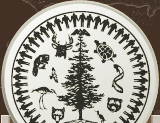In 1972, the Mohawk Nation Council of Chiefs at Kahnawake authorized the formation of the Kahnawake Warrior Society as a means to carry out the resolutions of the Clans in Council and to serve as the defensive vanguard of the Longhouse. Since that time, generations have embraced their duties and responsibilities as Haudenosaunee men.
In the Haudenosaunee tradition; the Rotisken’rakéhte, often referred to as the Mohawk Warrior Society, are responsible for national defense and public security in the Territory of Kahnawake.
The term Warrior Society is an English expression that identifies what we call in our language, Rotisken’rakéhte. Some believe that the root word, o’kén:ra meaning earth or soil, applying the connotation of earth carriers upon the society. Others believe that this term comes from the root word óhstien, meaning bones, referring to those who are carrying the bones, suggesting that it is the responsibility of the nation’s young men to carry the legacy of their ancestors and ensure the survival of their ancient way of life; Kanonhsonni’kéha or the way of the Longhouse.
Regardless of its literal translation, the term Rotisken’rakéhte is generally used to describe Haudenosaunee men who embrace their responsibility to protect and defend their people and territory. The term Warrior Society was recently adopted in the 1970's as a result of Canadian and American oppression. Those original young men who resurrected the ancient fighting sprit and reinstituted the Warrior Society adopted this somewhat appropriate and prolific English term to inspire hope amongst Iroquoian men and caution into the hearts of the colonial governments of Canada and United States.
With that introduction established, let us now identify what the Warrior Society is in the Haudenosaunee tradition. In the simplest of definitions, the Warrior Society is an ancient order of Haudenosaunee men who gather to aid their people in time of need and act as the voluntary vanguard of the Haudenosaunee. During times of strife and danger, its purpose is to defend and protect the citizenry and territory of the Haudenosaunee Six Nation Iroquois Confederacy.
The Warrior Society act not only as a defensive vanguard, but also as an important social institution providing essential services to the people; especially those unable and underprivileged. The Warrior Society helps community members who need their firewood piled, gardens tilled, and snow removed whenever and wherever needed. A Warrior Society that operates in this fashion would be described as the humble servants of the people and the power of the people in action.
Through promoting the traditional principles embedded in teachings of Kanonhsonni’kéha, the Warrior Society complement the people’s ultimate authority by upholding and enacting the Kaianere’kó:wa which in essence, is the living Constitution of the Iroquois Confederacy. Furthermore, the Warrior Society is also responsible for upholding and enacting any political determinations made by the Confederacy’s Grand Council, individual National Councils, or territorial Longhouse Councils.
Internally, the Warrior Society serves as peacekeepers and mediators in conflicts, ensuring that peace and harmony continue to be a priority within our territories. When requested of them by the Clans in Council, the Warrior Society serves as the envoys of peace in international disputes and disturbances.
The Warrior Society also provides a lifestyle of education and self-betterment, gathering to improve their knowledge of the old ways and exercise their roles and responsibilities as Haudenosaunee men. During these study groups, warriors engage in activities to learn our language, our ceremonial speeches, and of course our traditional songs and dances.



